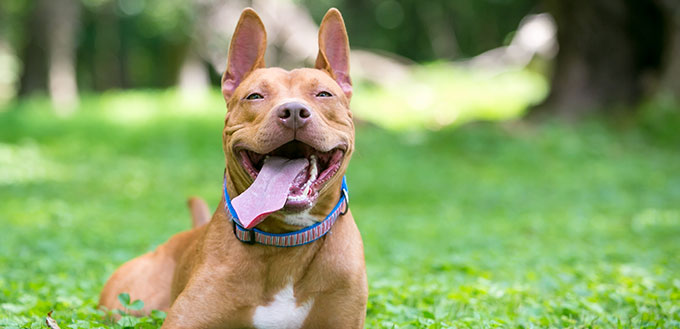As a pet owner, every little thing that we notice about our dog can become a concern. New pet owners are especially prone to over-worrying, but such things are completely normal and vets have seen thousands of frantic pet owners whose concerns have turned out to be something utterly benign. Today, we take a look at your dog’s tongue, so that you can better understand what you’ve seen and why your dog’s tongue looks like that.
All about Black-Spotted Tongues
Black tongue spots in your dog’s mouth may not be something that you notice right away. This is because they aren’t always there from birth, and they can develop over time, as your dog ages.
Togue spots are extremely visible against the natural pink color of a dog’s tongue, but just because they’re there, doesn’t mean that they’re harmful.
What are the Black Spots on My Dog’s Tongue?
The black spots that are on your dog’s tongue are no different from finding a new mole or freckle on your skin as a human. These spots usually occur because of a simple discoloration of your dog’s skin. Like humans, they can show up just about anywhere. This includes, but is not limited to, their paw pads, legs (though these are likely to be hidden beneath their fur), and yes, their tongue.
A spotted tongue is no different to a human having a birthmark. In most cases.
My Dog Has a Black Tongue
If your dog has a fully black tongue, rather than the pink tongue that you’ve seen from every other dog breed, we want you to take a deep breath and not panic. Did you know that some dog breeds have naturally black tongues, rather than pink? Examples of these breeds include the Chow Chow, the Chinese Shar-Pei and the Miniature Shar-Pei, and even some Labradors!
Can the spots hurt my dog?
They definitely shouldn’t. As we’ve mentioned, these spots on their tongue are normal. Take a look at your dog’s paw pads – are they all one color, or do they have markings, spots, patterns, etc.? Your dog’s tongue is just like their paw pads. Their skin can have these patterns and discolorations.
Do all dogs have tongues with black spots?
Many do! But that’s not saying that every single dog on the planet has a black tongue or tongue spots. Some dogs have naturally occurring black tongues – like Chow Chows – and most other dog breeds will have a pink tongue or a pink tongue that has spots of some kind.
Whether your dog has a spotted tongue, a black tongue, or a pink tongue, provided that it’s not causing them any pain and that your vet says that your dog is fine, you shouldn’t have any cause for concern.
When you Should be Concerned
If the spots have always been there or they’ve developed over time, your dog will be fine. Black spots are normal and 99.9% of the time, there’s nothing for you, as a dog owner, to get stressed about. You should only be worried about spots on a dog’s tongue if they appear inflamed or if your dog seems to be in pain.
These spots shouldn’t be black. They’ll be red, maybe appear kind of white, they’ll look painful. They make be flat or they be look like lumps. These aren’t natural dog tongue spots. These are caused by a medical issue and need to be treated.
Now, the phrase “medical issue” sounds scary to everyone, but your dog could just have ulcers. Ulcers often appear as round lumps or spot-like patches on tongues and around the mouth. Mouth ulcers are painful but treatable. You may also notice them on your dog’s lips, gums, and their inner cheeks. You may find that they stop eating as much or start whining and making distressed sounds.
Ulcers, sores, and the like, can be treated with medication, gels, creams… What we’re getting at is that your vet will have seen a lot of them.
Causes of mouth ulcers and sores in dogs
Common causes of mouth ulcers and sores that affect dog’s tongues and the surrounding area are as follows:
- Bacteria
- Environmental allergies
- Food allergies
- Infection
- Plaque on the teeth
While the medical conditions and issues here are treatable, things like allergies are a bit more difficult to sort out. This is because you may not yet know what your dog is allergic to. It’s best to start with the most obvious cause and consult your vet about the possibility of allergies while you get your dog treated for this more painful version of tongue spots.
Your best friend will be fine. It’s extremely unlikely that ulcers or mouth sores are a symptom of anything more dangerous or fatal. But better safe than sorry, always get your pup checked out. Dog owners aren’t vets. The internet is great! But they can’t diagnose or treat your dog.
Canine melanoma
A common tumour that occurs in dogs. It is grown from cells that produce pigment, which is why it often looks like a dark spot. These can occur inside your dog’s mouth and do need treatment.
Dogs that are diagnosed with Canine Malignant Melanoma can survive for several months after surgery, depending on the factors surrounding the condition. It is fatal if left untreated, but is also not something that a dog owner would mistake for a random pigment spot on their dog’s tongue. Melanoma forms in lumps and appears inflamed and painful.
Squamous Cell Carinoma
Squamous Cell Carinoma is a type of skin cancer that is formed in the cells that make up the middle and outermost layers of the skin. Unlike Melanoma, it is not a condition that is inherently life-threatening, but it can be a fast-developing and aggression condition.
Again, like Melanoma, this cancer can form in a dog’s mouth and appears as black or very dark red lumps on their skin and/or gums.
Myths about the Dogs Tongue and its Spots
It seems like a strange subject but dogs tongues are well discussed in history. There’s quite a few myths that surround them, and even a few tales about dog tongues and spots on the tongue.
Dogs with spotted or black tongues are part Chow Chow – This, unfortunately, isn’t true. Your pup may be a mixed breed dog, but you’ll know about it if you get them from a breeder. Having a dog with black on their tongue doesn’t automatically make them part Chow Chow. There are other dog breeds with black tongues, and spotted tongues occur in a huge number of dogs.
Spots on your dog’s tongue show that they aren’t purebred – also not true. The American Kennel Club does judge tongue color in some cases but it’s reserved for dog breeds with black tongues that have pink spots.
Black spots are a sign of illness or injury – Nope, not at all. They are just skin pigmentation, like freckles on humans.
Tongue spots come in set patterns – Again, no, they don’t Spots on your dog’s tongue (like freckles on humans) can come in all kinds of patterns and numbers. Your dog could have one black spot, several, or even whole patches of black.
Dog Breeds and Their Tongues
Let’s talk about some popular dog breeds and the variations of their tongues that are common. Melanin is the natural skin pigment that is responsible for the color of your dog’s tongue, paw pads and toenails, and every other part of your dog. Some dogs have more melatin, causing darker points across their body, a spotted or black tongue, and dark eyes, others have less and may be fully white with light blue eyes and a pink tongue.
Chow Chows
Born with a blue-black tongue, Chow Chows are a great example of why you shouldn’t be worried about a black spot on your dog’s tongue. Skin pigmentation doesn’t affect the entire body evenly, which is why you get white and tan Chow Chows that still have bluish-black tongues.
Dogs with spotted tongues
This list isn’t exhaustive, but you can expect that any dog breed listed here could produce the traits that cause a tongue spot.
- Akita
- Australian Cattle Dog
- Australian Shepherd
- Bichon Frise
- Chinese Shar-Pei
- Collie
- Cocker Spaniel
- Dalmatian
- Doberman Pinscher
- English Setter
- Flat Coated Retriever
- German Shepherd
- Golden Retriever
- Gordon Setter
- Great Pyrenese
- Irish Setter
- Keeshond
- Kerry Blue Terrier
- Korean Jindo
- Labrador Retriever
- Mastiff
- Miniature Shar-Pei
- Mountain Cur
- Newfoundland
- Pomeranian
- Pug
- Rhodesian Ridgeback
- Rottweiler
- Shiba Inu
- Siberian Husky
- Soft Coated Wheaten Terrier
- Tibetan Mastiff
Fun fact: A puppy can be born with a black or spotted tongue, as well as a number of other birthmarks. These can occur from the bottom of their paws to their eyes (yes, even along the eye rims!), and anywhere in between! It is completely normal for your puppy to be born with melanin levels that cause black tongues and birthmarks.
Note: The advice provided in this post is intended for informational purposes and does not constitute medical advice regarding pets. For an accurate diagnosis of your pet's condition, please make an appointment with your vet.









